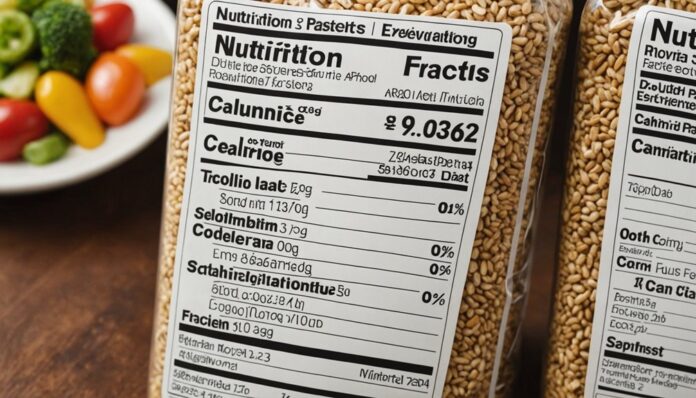Nutrition labels have undergone significant changes by 2025, prioritizing transparency and consumer enablement. Added sugars are now a mandatory disclosure, and serving sizes have been updated to reflect realistic consumption habits. Daily values have been revised to align with current nutritional science. These changes aim to facilitate informed dietary choices, but their impact on consumer behavior and the food industry remains to be seen, sparking curiosity about the broader implications.
Highlights
- Food manufacturers now disclose added sugars on nutrition labels to increase consumer awareness and reduce sugar intake.
- Serving sizes have been updated to reflect typical consumption amounts, promoting realistic eating habits and portion control.
- Daily values have been updated to reflect current nutrient science, impacting nutrient communication on labels and helping consumers make informed decisions.
- Label changes aim to promote transparency and respond to rising consumer demand for nutritional information, driving industry innovation and product reformulation.
- Emerging trends include digital labels, QR codes, eco-labels, and augmented reality, which will shape the future of nutrition labeling.
Added Sugars: A New Focus on Transparency
How transparent are food manufacturers when it comes to added sugars in their products?
Recent added sugar regulations aim to increase transparency and promote consumer awareness. Food manufacturers are now required to disclose the amount of added sugars in their products on nutrition labels.
This change allows consumers to make informed decisions about their sugar intake. The goal is to help reduce the overall consumption of added sugars, which has been linked to various health issues.
By providing clear and concise information, consumers can better understand the ingredients in their food and make healthier choices. As a result, manufacturers are reformulating their products to reduce added sugars, ultimately contributing to a healthier food environment.
Consumer awareness is key to driving this positive change.
Updated Serving Sizes: What You Need to Know
As part of the ongoing effort to improve nutrition labeling, serving sizes have been updated to better reflect the amounts people typically consume in one sitting.
These serving size adjustments aim to provide a more realistic representation of eating habits, helping consumers make informed decisions about their diets. The changes are designed to promote portion control, a vital aspect of maintaining a healthy lifestyle.
By providing more accurate serving sizes, labels will now more accurately reflect the nutritional content of food products. This update will enable individuals to better manage their daily intake and make healthier choices.
With these changes, consumers will have a clearer understanding of the food they eat and be empowered to take control of their nutritional well-being.
Redefining Daily Values: Changes to Nutrient Reference Amounts
While the updated serving sizes provide a more realistic representation of eating habits, another essential aspect of nutrition labeling is also undergoing significant changes: the daily values used to calculate the percentage of nutrients in a food product.
Daily value updates will impact how nutrient content is communicated to consumers. New nutrient guidelines are being implemented to reflect current scientific understanding of nutrient needs.
These changes aim to help consumers make informed decisions about their diet and guarantee that nutrition labels accurately represent the nutritional value of food products.
As a result, food manufacturers must adjust their labeling to comply with the updated daily values, which will provide a clearer illustration of a product’s nutritional content.
Behind the Scenes: The Science of Nutrition Label Updates
The revisions to daily values mark a significant step forward in providing consumers with more accurate and reliable nutrition information.
These updates are the result of extensive scientific research and regulatory changes aimed at reflecting the latest understanding of human nutrition and dietary needs.
Behind the scenes, experts from various fields, including nutrition science, epidemiology, and food technology, collaborated to review and update the daily values.
This process involved analyzing data from numerous studies, considering factors such as age, sex, and overall health status.
By incorporating the latest scientific findings, the updated nutrition labels will enable consumers to make informed decisions about their diets, nurturing a greater sense of control and connection to their overall well-being.
Regulatory changes will continue to shape the evolution of nutrition labels.
Industry Impact: How Label Changes Affect Food Manufacturers
Implementing the revised daily values on nutrition labels will require significant adjustments from food manufacturers. To achieve label compliance, companies must reformulate products, update packaging, and adjust manufacturing processes.
These changes can be costly and time-consuming, particularly for small and medium-sized businesses. Manufacturing adjustments may involve retraining staff, investing in new equipment, and modifying supply chains.
Some manufacturers may need to reformulate products to meet new standards, which can be a complex and expensive process. Despite these challenges, many manufacturers see the updated labels as an opportunity to showcase their commitment to transparency and customer well-being.
The Added Sugar Effect: How Label Changes Influence Consumer Behavior
Consumers scrutinizing nutrition labels are likely to be most influenced by the added sugars information, as it provides a clear indication of a product’s sugar content.
The explicit declaration of added sugars on labels has heightened consumer awareness, prompting them to reevaluate their dietary choices. As a result, consumers are making more informed decisions, choosing products with lower added sugar content.
This shift in consumer behavior is driving demand for products with cleaner labels and fewer added sugars. The increased transparency has also led to a greater emphasis on sugar reduction in product reformulation.
By providing clear information, the new labels enable consumers to make healthier choices, ultimately contributing to a reduction in sugar consumption and a healthier population.
Added sugar awareness is now a key factor in shaping consumer choices.
Clearer Labeling for Better Choices: The Benefits of the New Design
As nutrition labels continue to evolve, a key aspect of the new design is its ability to facilitate informed decision-making.
The revised label features a more streamlined visual design, making it easier for consumers to quickly locate and understand essential information. This redesign supports consumer education by providing clear and concise data about nutritional content.
Consumers can now make better choices about the foods they eat, thanks to the increased transparency of the label. The updated design also enables consumers to identify and compare key nutritional elements, such as calories, added sugars, and sodium content.
From Label to Table: How Nutrition Labels Shape Our Understanding of Health
While the revised nutrition label is an essential step toward promoting informed decision-making, its impact extends far beyond the grocery store shelf.
As consumers become more aware of the information presented on labels, their comprehension of nutritional content improves, enabling them to make healthier choices. This increased label comprehension is closely tied to health literacy, which is critical for maintaining a balanced diet and mitigating the risk of chronic diseases.
As consumers grasp the significance of nutritional information, they are equipped to take control of their well-being. By bridging the gap between nutritional knowledge and practical application, the revised label plays a crucial part in shaping the public’s understanding of health and nurturing a culture of informed, health-conscious individuals.
The Future of Nutrition Labels: Trends and Innovations to Watch
Building on the success of the revised nutrition label, several emerging trends and innovations are ready to change the way nutritional information is presented and used.
One trend is digital labeling, which allows consumers to access detailed nutritional information via scannable codes or apps. This feature provides more thorough data and alleviates packaging clutter.
Another innovation is augmented reality (AR) technology, which overlays digital information onto physical labels. AR enhances the shopping experience by offering interactive content, such as recipe suggestions and nutritional comparisons.
These advancements aim to increase consumer engagement, improve transparency, and nurture a deeper understanding of nutritional information, ultimately enabling individuals to make informed choices about their health and well-being.
As technology continues to evolve, the future of nutrition labels looks promising.
Conclusion
The updated nutrition labels of 2025 prioritize transparency and consumer enablement. With clear disclosures of added sugars, updated serving sizes, and refined daily values, consumers can make informed dietary choices. The labels’ innovative features, such as QR codes and eco-labels, provide personalized and sustainable information. These changes promote healthier eating habits, increase health literacy, and have a significant impact on the food industry, shaping the future of nutrition labeling and public health.


